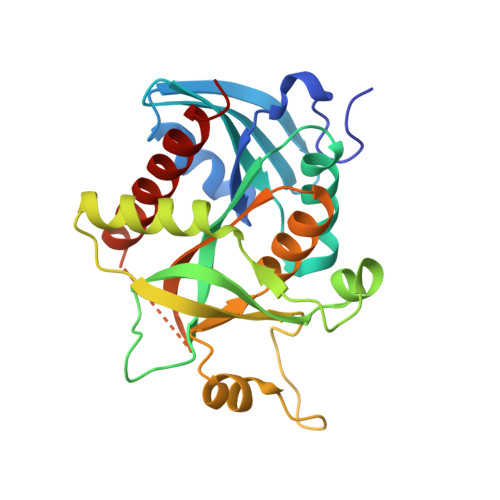Genetic resistance to purine nucleoside phosphorylase inhibition in
Ducati, R.G., Namanja-Magliano, H.A., Harijan, R.K., Fajardo, J.E., Fiser, A., Daily, J.P., Schramm, V.L.(2018) Proc Natl Acad Sci U S A 115: 2114-2119
- PubMed: 29440412
- DOI: https://doi.org/10.1073/pnas.1525670115
- Primary Citation of Related Structures:
6AQS, 6AQU - PubMed Abstract:
Plasmodium falciparum causes the most lethal form of human malaria and is a global health concern. The parasite responds to antimalarial therapies by developing drug resistance. The continuous development of new antimalarials with novel mechanisms of action is a priority for drug combination therapies. The use of transition-state analog inhibitors to block essential steps in purine salvage has been proposed as a new antimalarial approach. Mutations that reduce transition-state analog binding are also expected to reduce the essential catalytic function of the target. We have previously reported that inhibition of host and P. falciparum purine nucleoside phosphorylase ( Pf PNP) by DADMe-Immucillin-G (DADMe-ImmG) causes purine starvation and parasite death in vitro and in primate infection models. P. falciparum cultured under incremental DADMe-ImmG drug pressure initially exhibited increased Pf PNP gene copy number and protein expression. At increased drug pressure, additional Pf PNP gene copies appeared with point mutations at catalytic site residues involved in drug binding. Mutant Pf PNPs from resistant clones demonstrated reduced affinity for DADMe-ImmG, but also reduced catalytic efficiency. The catalytic defects were partially overcome by gene amplification in the region expressing Pf PNP. Crystal structures of native and mutated Pf PNPs demonstrate altered catalytic site contacts to DADMe-ImmG. Both point mutations and gene amplification are required to overcome purine starvation induced by DADMe-ImmG. Resistance developed slowly, over 136 generations (2 136 clonal selection). Transition-state analog inhibitors against Pf PNP are slow to induce resistance and may have promise in malaria therapy.
- Department of Biochemistry, Albert Einstein College of Medicine, Bronx, NY 10461.
Organizational Affiliation:



















